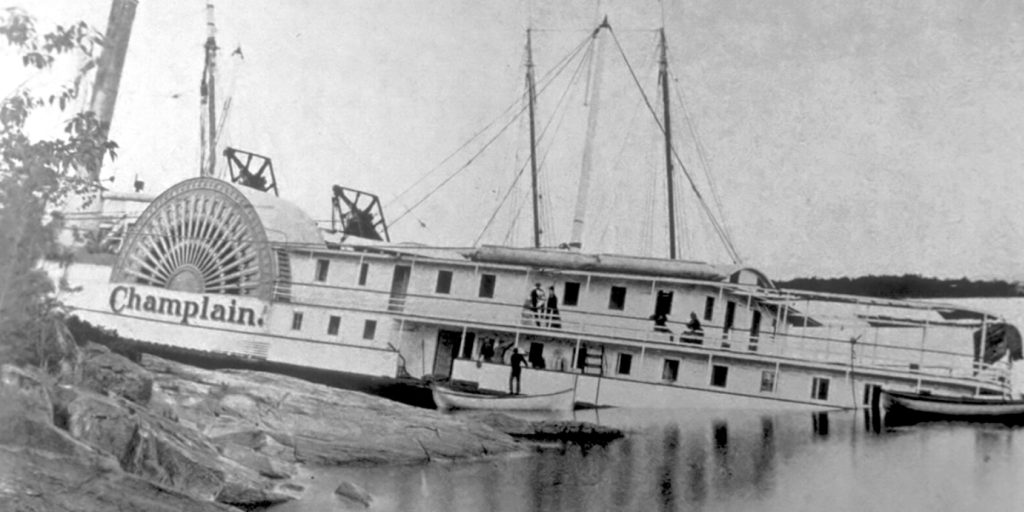
Lake Champlain is known for its picturesque and peaceful waters – but a dive beneath the surface shows just how deep its history goes.
The lake’s namesake Samuel de Champlain was certainly not the first to ply its waters. As the Lake Champlain Maritime Museum points out, people have been interacting with the lake for centuries for transportation, food, trade, war, and fun – leaving behind many artifacts as clues about how life was lived in the region.
Those artifacts tell fascinating, enlightening and at times wild tales.
About 300 shipwrecks, plus 10,000 objects and archives have been conserved by the Lake Champlain Maritime Museum. The museum, located on the shore in Vergennes, is dedicated to protecting and sharing the cultural and natural heritage of Lake Champlain.
Several of those shipwrecks are what one would imagine: the result of late-night crashes after some sort of accident. Some, such as the Steamboat Phoenix, are shrouded in mystery. All tell a story about life on the lake at the time of the ship’s demise.
Overall, the scuttled ships are a diverse group, from war ships to a horse-powered ferry. What they have in common is their remarkable condition.
“The cold dark fresh water of Lake Champlain is just a wonderful preservative environment,” said Chris Sabick, director of research and archeology at the Lake Champlain Maritime Museum. “Some of these vessels look like they were literally just sailed down to the bottom of the lake. They still have paint on them, the masts are still standing in some cases. The artifacts of the people that lived and worked on the boat are often still there and well preserved.”
That’s a good thing, because as Sabick says, the underwater artifacts and vessels are sometimes the only record left of everyday life and commerce from an era.
“They are really time capsules that preserve a specific moment in time really well and that moment in time is often underrepresented in the written history,” said Sabick.
He points to the canal boats that were essential to commerce in the region. As the historical equivalent of today’s tractor trailer trucks, canal boats were background scenery left out of written documentation. Their wrecks offer a glimpse at the economy, life, and work of that period.
“In many cases they’re the only permanent physical record we have of people’s lives and livelihoods and the watercraft that they lived and worked on,” said Sabick.
The Steamboat Phoenix that now sits on the bottom of the lake is the oldest steamboat shipwreck in the world, according to Sabick. It first launched in 1815 as the second commercial steamboat on Lake Champlain.
Four years later, on September 4, 1819, the boat was traveling to Plattsburgh, N.Y., from Burlington with 46 people aboard. A fire was discovered at about 11 p.m., too late to save the boat, according to the Maritime Museum’s account.
“The passengers were roused from their cabins and loaded into two small boats. Unfortunately, in the confusion, a dozen people (including the captain) were left to fend for themselves on the burning ship,” reads the museum’s history.
The captain and several others were rescued in the morning, but six people died. For many shipwreck tales, the story could end there – but for the Steamboat Phoenix, mystery remains.
“The cause of the fire was said to have been a candle carelessly left burning in the pantry; however, circumstantial evidence suggests that the fire may have been intentionally set by competing lake sailing interests,” according to the museum.
More of the Phoenix’s story continues to be uncovered. Just last year a local shipwreck explorer, Gary Lefebvre, found the steamboat’s two long lost paddle wheels – more than 200 years after they drifted to the bottom, and 40 years after the discovery of the ship’s hull.
The Steamboat Phoenix is part of the Vermont Underwater Historic Preserve, which is managed by the Lake Champlain Maritime Museum in partnership with the Vermont Division of Historic Preservation. The Underwater Historic Preserve provides public access for divers to some of the shipwrecks, while protecting the sites from damage.
This summer season, the Lake Champlain Maritime Museum will write a new chapter for itself. For the first time there will be no entrance fee for visitors. The indoor exhibits remain temporarily closed, but outdoor exhibits will be available daily from 10 a.m. to 4 p.m.
As in other years, visitors will be able to explore the schooner Lois McClure, a full-scale replica of an 1862-class sailing canal boat based on two shipwrecks in Burlington Harbor. The plan for this season was to keep the ship docked, but visitors can climb on board to learn about its history and what life on the canal schooner was like.
Waiving the entrance fee has been a goal for the museum, said Megan Salocks, director of marketing and engagement, and the hope is to make that permanent.
After the campus was closed for nearly all the 2020 season, the staff was excited to welcome the public back to the grounds. Speaking a week before opening day, Salocks said she was particularly fond of this season’s exhibit on Prohibition in Vermont.
“There are some common themes that connect to our world today. It’s really exciting to bring those stories out and let people see the connections,” Salocks said.
Shipwreck fans can find a wealth of information about more than 70 wrecks on the museum’s website, including virtual tours of three wrecks with underwater video and narration of their dramatic tales. In years without Covid restrictions, the museum offers shipwreck cruises on which visitors can view live video taken by remote controlled underwater vehicles.
Salocks said the museum regularly hosts talks about shipwrecks, follow the museum’s social media channels to learn more about virtual and in-person events.
More Information
Lake Champlain Maritime Museum: Lcmm.org
Read and watch more about the Steamboat Phoenix fire and remains.
More information about the Vermont Underwater Historic Preserve: Historicsites.vermont.gov/underwater-preserves
Book recommended by Chris Sabick: Sails and Steam in the Mountains: A Maritime and Military History of Lake George and Lake Champlain, by Russell Bellico.
“It’s my go-to reference for everything. The first time I look up something, that’s where I start,” Sabick said.
Clover Whitham has been a journalist at Vermont newspapers for more than a dozen years and is now a freelance writer and editor near Burlington.
Photo provided by Lake Champlain Maritime Museum
Related Articles & Free Vermont Maturity Subscription

Skiing in Vermont: Big Ideas and Quirky Characters
The Vermont Republic – The Story of When Vermont was an Independent Country






Comment here